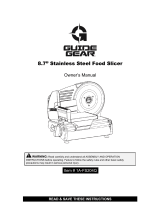
– 6 –
3. To remove the pusher plate, hold the pusher plate handle, raise the pusher plate and swing it out
to the left so that the feed cylinder is set in the open position.
4. Take hold of the pusher plate with both hands (Fig. 2).
5. Rotate pusher plate until the pin on the shaft is out of the slot on the bracket. Pull the pusher plate
up and away with the right hand.
FITTING AND REMOVING THE CUTTING TOOLS
Slicing, Shredding, Grating, and Julienne Cutting
1. Using the pusher plate handle, raise the pusher plate and swing it to the left so that the feed cylinder
is set in the open position.
2. Release the feed cylinder lock by turning the lock handle counterclockwise. Then swing the feed
cylinder out to the right.
3. Place the ejector plate on the knife shaft. Press the ejector plate all the way down and turn until
the plate is in the locked position.
4. Select the appropriate cutting tool for the job. Place it on the shaft, turning until engaged.
5. Screw the decoring screw hand tight counterclockwise into position in the cutting tool center.
6. Swing the feed cylinder back to the left and turn the lock handle clockwise into locked position.
Dicing and French Fries
1. Follow Steps 1 through 3 above.
2. When dicing, place a suitable dicing grid (see Cutting Tool Guide) in the knife chamber and turn
the dicing grid clockwise as far as it will go.
When cutting straight potato chips, place the potato chip grid in the knife chamber and turn the
potato chip grid clockwise as far as it will go. For best cutting results, the direction of the potato
chip grid blades and positioning of the potato should be as shown in Fig. 5.
3. Select the appropriate cutting tool. Place it on the shaft, turning until engaged.
4. Screw the decoring screw hand tight counterclockwise into position in the cutting tool center.
5. Swing the feed cylinder back to the left and turn the lock handle clockwise into locked position.
If you use the wrong combination of dicing grid and slicing tool (see Cutting Tool Guide), the following
may result:
• The feed cylinder cannot be closed.
• The space between the dicing grid and the slicing tool is too large and leads to poor cutting results.















